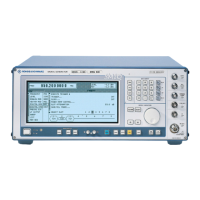SMIQ Digital Standard 3GPP W-CDMA (FDD)
1125.5555.03 E-92.229
2.14.3.3.5 Use of Timing Offset
All previous scenarios did not use a timing offset. Therefore all channels contained the same bits at
least in the pilot symbol part. The result of this special feature was that the 4 corner points (0, 2*number
of channels), (0, -2*number of channels), (2*number of channels, 0), (-2*number of channels, 0) where
always there (constructive superposition).
Through the use of a timing offset (in our example 1 unit (=256 chips) from channel to channel) the data
bits (including pilot and TPC) are shifted against each other.
Note: In contrast to earlier versions of the W-CDMA standard or WinIQSIM, the timing offset
(previously "data offset") is no longer defined in symbols but in units of 256 chips. Thus shifting
becomes independent of the spreading factor.
The worst case is thus eliminated, the crest factor becomes smaller and the spread symbols are
arranged as follows:
Fig. 2-155 Constellation diagram of 16 DPCHs with timing offset
Through the use of the timing offset the crest factor was reduced by approx. 4 dB to 12.26 dB.
The effect of the timing offset increases with the number of channels. If for instance 64 channels are
used, the crest factor is reduced from 18.57 dB to 12.28 dB.

